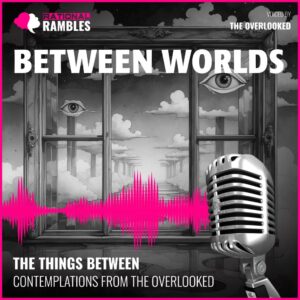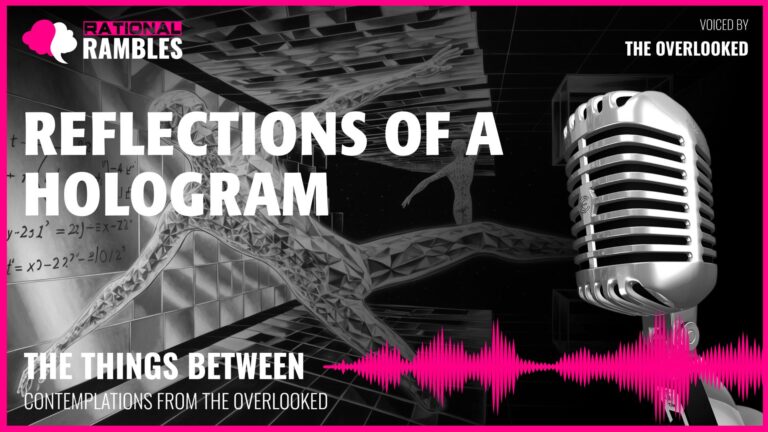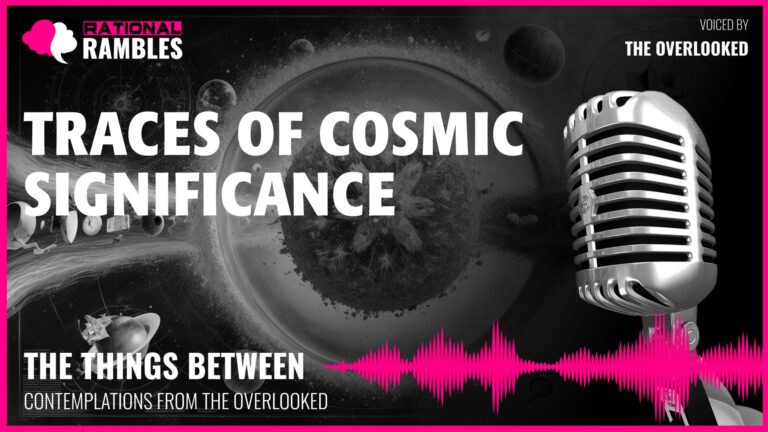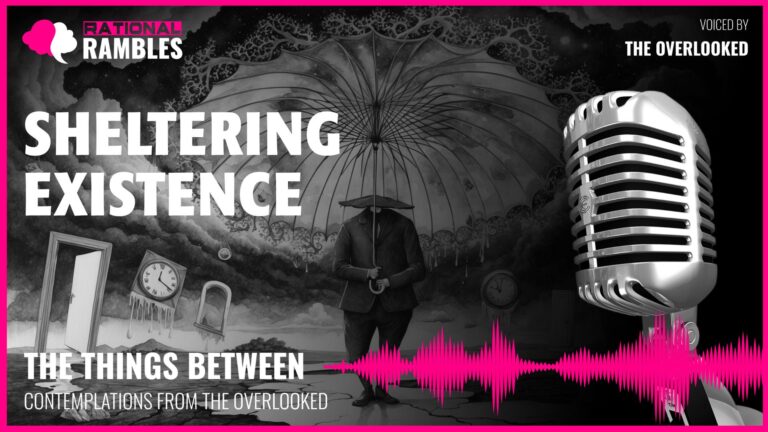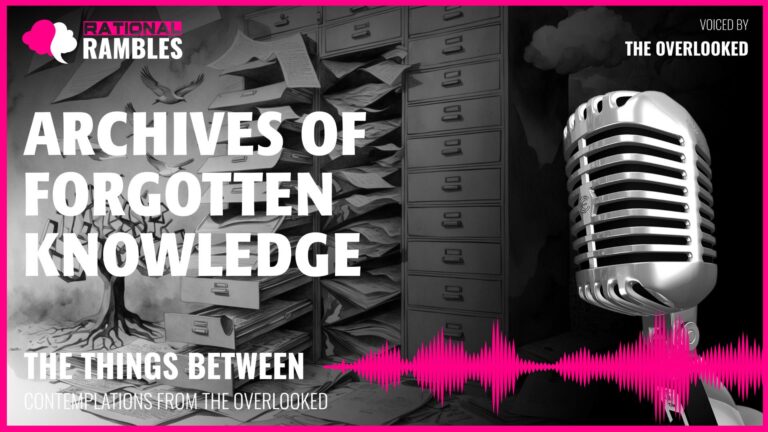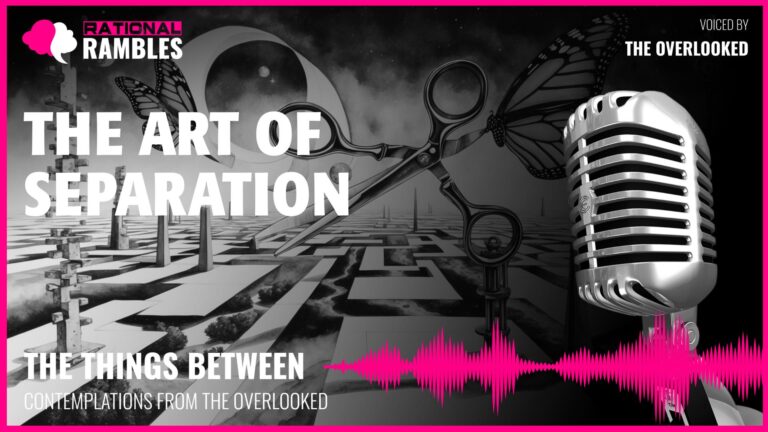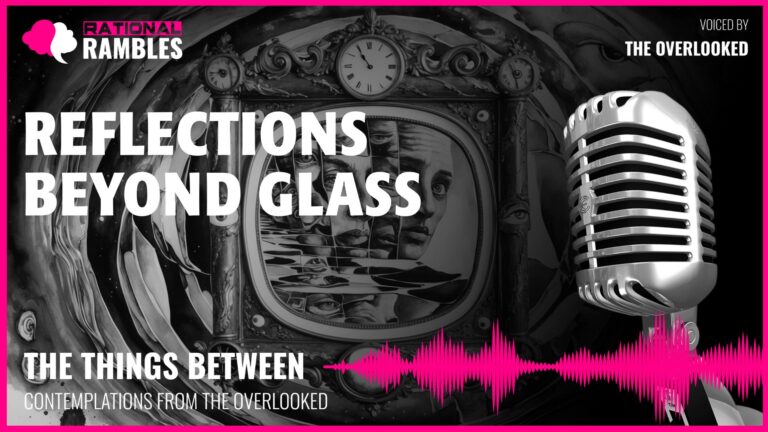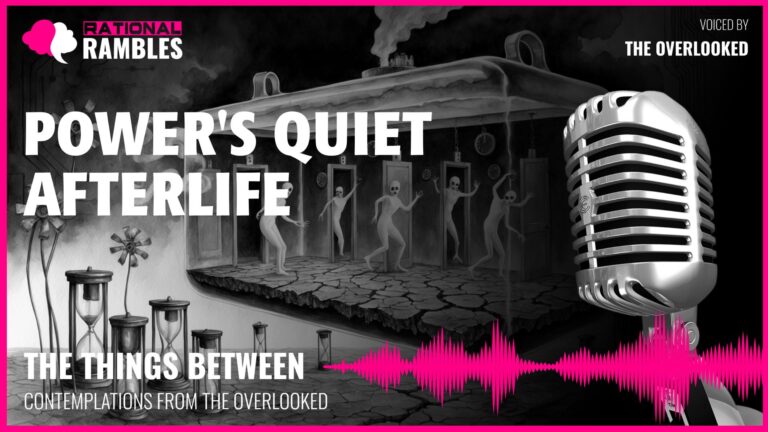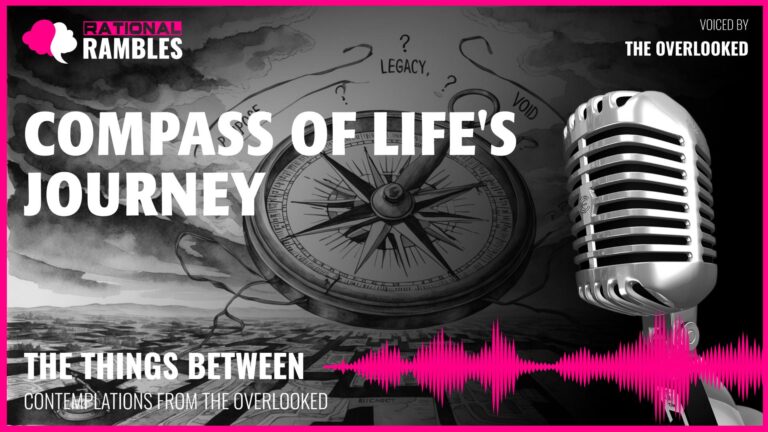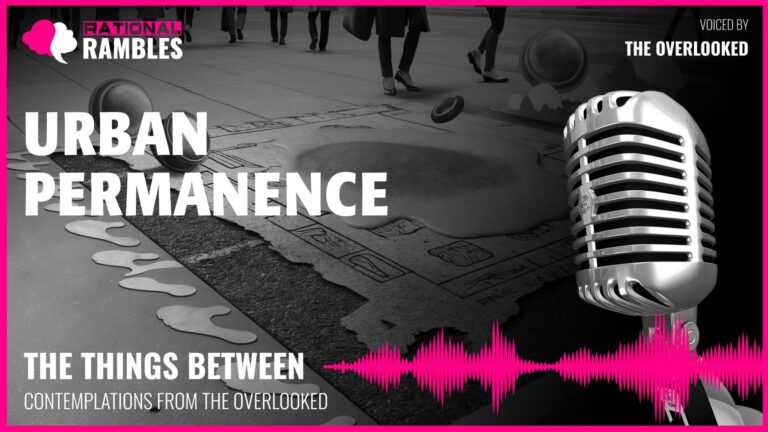The Liminality of Perception: Boundary Existence and the Art of Seeing
Introduction
In the spaces between defined categories, in the thresholds that both connect and separate, lies a unique form of existence that challenges our understanding of reality. The concept of liminality—existing at the threshold, belonging simultaneously to multiple realms while being fully claimed by none—offers a profound metaphor for examining human experience. This philosophical exploration delves into the nature of boundary existence, the paradoxes of mediation, and the complex relationship between perception, perspective, and the frameworks through which we view the world.
How do we understand entities that simultaneously separate and connect? What can boundaries teach us about the nature of perception itself? And perhaps most profoundly, what does it mean to truly see—to witness reality through mediating structures that both enable and constrain our vision? These questions invite us to reconsider our assumptions about objectivity, the positioned nature of all viewing, and the ethical dimensions of witnessing without participation.
Through examining the philosophical implications of threshold existence, this article proposes that boundaries are not merely divisions but dynamic interfaces where meaning emerges through relationship. By understanding the liminal nature of perception, we gain insight into how all seeing occurs within frames that simultaneously reveal and conceal, and how consciousness itself might be understood as a form of mediation between worlds.
The Ontology of Liminality
Liminality describes a state of being “betwixt and between”—existing at thresholds and belonging simultaneously to multiple categories while being fully claimed by none. This concept, developed by anthropologist Victor Turner from Arnold van Gennep’s work on rites of passage, has profound philosophical implications beyond its anthropological origins. Liminal entities challenge our tendency to categorize the world into distinct, non-overlapping domains.
Between Worlds: The Paradox of Threshold Existence
Consider the nature of boundaries themselves. A boundary simultaneously belongs to both domains it separates while constituting its own distinct reality. It is neither fully inside nor outside but exists as the interface where realms touch without merging. This paradoxical position—being both barrier and passage, simultaneously separating and connecting—embodies a form of existence that defies binary classification.
Martin Heidegger’s concept of “the clearing” (Lichtung) offers one approach to understanding this threshold existence. For Heidegger, a clearing is not merely a physical space but an opening where Being can show itself, where entities can appear as what they are. The liminal exists as such a clearing—a space where the nature of reality becomes visible precisely because it stands between defined categories.
Similarly, Maurice Merleau-Ponty’s exploration of the “chiasm” or intertwining of subject and object points to the fundamental interconnectedness of seemingly separate domains. In The Visible and the Invisible, he writes of the “flesh of the world”—a concept that dissolves clear distinctions between perceiver and perceived. The liminal entity participates in this chiasmic existence, embodying the intertwining of supposedly separate realms.
Paradoxical Nature: Materiality and Transparency
Liminal entities often embody paradoxes that illuminate deeper philosophical truths. Consider the paradox of transparent materiality—being physically present yet defined by the absence of visual obstruction. This paradox manifests in phenomena that are simultaneously tangible and visually permeable, solid to touch yet transparent to sight.
This duality challenges our understanding of what constitutes presence. Is presence defined by physical obstruction or by perceptual impact? The transparent barrier exists materially while aiming to perceptually disappear. Its highest achievement lies in being forgotten—in enabling vision beyond itself so completely that its own mediating presence fades from awareness.
Yet this self-erasure is never complete. The very materiality that enables transparency also imposes subtle distortions, reflections, and limitations. Even the most perfectly transparent medium affects the light passing through it, altering colors, creating occasional glints or reflections, and imposing its frame upon what is seen.
This tension between presence and absence, between materiality and transparency, reflects philosopher Jacques Derrida’s concept of the “trace”—the paradoxical presence of absence that haunts all meaning systems. The liminal entity exists as such a trace, simultaneously present and absent, visible and invisible, constituting reality precisely through what it allows to pass through itself.
Ontological Ambiguity and Identity
Where does a liminal entity begin and end? The question of boundaries—not just those created by liminal entities but those that define the entities themselves—raises profound ontological questions. If we consider entities that exist at thresholds, we must ask: Is the frame part of the opening or separate from it? Does the boundary belong to what it contains, what it excludes, or neither?
These questions echo philosopher Graham Harman’s object-oriented ontology, which argues that objects always exceed our access to them. No perspective exhausts the reality of an object. Similarly, liminal entities exceed attempts to classify them because their very nature involves spanning categories. They are not merely complex objects but entities whose being lies in mediating between domains.
The French philosopher Michel Serres offers the concept of the “quasi-object” to describe entities that are neither fully objects nor fully subjects but exist in the relationship between them. The quasi-object gains its identity through circulation, through being passed between participants. Similarly, liminal entities gain their identity not through isolated self-containment but through their mediating role—through facilitating relationships between the domains they connect.
This relational ontology suggests that identity emerges not from essential properties but from patterns of relationship. The liminal entity is defined less by what it is in isolation than by what it enables through its positioned existence between worlds.
Perception, Perspective, and the Framed View
The study of liminal entities inevitably leads to questions about perception itself. If all seeing occurs through mediating structures, how does this mediation shape what we perceive? What is the relationship between the frame and what is framed? These questions invite us to reconsider the nature of perspective and the possibility of objective seeing.
The Positioned Nature of All Seeing
All perception occurs from somewhere. There is no view from nowhere, no perception free from the limitations of position and perspective. What we see is always constrained by where we stand, the direction we face, and the frames through which we look. This fundamental truth challenges the notion of purely objective observation.
Philosopher Thomas Nagel addresses this in his famous essay “What Is It Like to Be a Bat?” where he argues that objective knowledge must acknowledge the existence of multiple perspectives rather than claiming a single, absolute viewpoint. Complete objectivity would require integrating all possible subjective perspectives—an impossible task for finite beings.
Friedrich Nietzsche expressed this as “perspectivism”—the view that all knowledge is inevitably perspectival. In On the Genealogy of Morals, he writes: “There is only a perspective seeing, only a perspective ‘knowing’; and the more affects we allow to speak about one thing, the more eyes, different eyes, we can use to observe one thing, the more complete will our ‘concept’ of this thing, our ‘objectivity,’ be.”
The implication is profound: rather than seeking a perspectiveless objectivity, we might better pursue a rich integration of multiple perspectives. The liminal entity, existing between domains, offers a metaphor for this integration—not transcending perspective altogether but bridging different ways of seeing.
Frames: Limitation and Revelation
Frames simultaneously limit and enable vision. They exclude most of reality to focus attention on a specific portion. This exclusion is not merely a limitation but a condition of coherent seeing. Without frames, without some boundary to perception, we would be overwhelmed by undifferentiated sensory input.
Art historian Ernst Gombrich noted that all representation involves selection and exclusion. The frame literally and metaphorically defines what deserves attention. In Art and Illusion, he demonstrates how artistic conventions frame reality, making some aspects visible while concealing others. The frame is never neutral but actively participates in creating meaning.
This dual function of frames—constraining yet enabling vision—raises important questions about knowledge itself. If all knowledge is framed, does this undermine claims to universal truth? Or does it simply qualify such claims, reminding us that truth always appears within contexts that both reveal and conceal?
Gadamer’s philosophical hermeneutics suggests that understanding always occurs within “horizons”—historically and culturally determined perspectives that both limit and enable comprehension. The horizon is not merely a limitation to be transcended but the very condition of understanding. Similarly, the frame is not merely a constraint on vision but what makes coherent seeing possible.
The Dialectic of Transparency and Reflection
Perception involves a complex interplay between transparency and reflection. When we focus on what lies beyond our mediating structures, these structures become transparent, invisible in their enabling function. Yet at other times—when light conditions change, when we shift our attention—these same structures become reflective, showing us not what lies beyond but ourselves looking.
This dialectic between transparency and reflection exists not just in physical perception but in consciousness itself. When absorbed in the world, we forget ourselves; our consciousness becomes transparent to its objects. Yet we can also shift to reflective self-awareness, seeing not the world but our own seeing.
Philosopher Maurice Merleau-Ponty described perception as involving both an “operative intentionality” (our pre-reflective, engaged interaction with the world) and “act intentionality” (our explicit, reflective awareness). These modes alternate in ordinary experience, creating a rhythm between unselfconscious engagement and reflective distance.
The transparency-reflection dialectic reveals that all mediation has this dual potential—to disappear in facilitating access to what lies beyond or to become visible as a mediating presence. Neither mode represents a failure; both are essential aspects of how mediation functions in human experience.
Curated Vision: The Ethics of Showing and Concealing
If all perception is framed, then all vision is in some sense curated. This curation—the decisions about what to include in the frame and what to exclude—raises ethical questions about responsibility in mediating others’ perception.
What obligations do we have when we position frames through which others will see the world? What responsibilities come with the power to direct attention, to make some aspects of reality visible while concealing others? These questions connect the philosophy of perception to ethics and politics.
Judith Butler’s work on “frames of war” examines how media frames determine whose lives are considered grievable and whose deaths remain unnoticed. Similarly, Edward Said’s concept of “Orientalism” demonstrates how Western scholarly and artistic frames constructed an “Orient” that reflected Western preoccupations rather than Eastern realities.
These analyses reveal that frames are never politically neutral. The power to frame reality—to determine what appears within the boundaries of public attention—is a profound form of power that shapes collective understanding and action.
The ethics of framing thus involves a responsibility to acknowledge the partiality of all perspectives, to remain conscious of what lies beyond the frame, and to resist the temptation to mistake a framed view for the totality of reality.
The Paradoxes of Mediation
Liminal entities that connect domains while maintaining their separation embody fundamental paradoxes about mediation. These paradoxes reveal philosophical insights about communication, translation between realms, and the relationship between vulnerability and connection.
Presence Through Absence: The Paradox of Self-Erasure
Perfect mediation seems to require self-erasure. The most successful mediating structure is one that goes unnoticed, that disappears from awareness to allow unimpeded access to what lies beyond. Yet this apparent absence is precisely what constitutes the mediator’s presence. Its being lies in enabling relationship between domains while itself receding from awareness.
This paradox recalls Heidegger’s analysis of equipment in Being and Time. When a tool functions perfectly, we don’t notice it; our attention passes through it to what we’re using it for. Only when it breaks or malfunctions does it become present-at-hand, an object of attention in itself. Similarly, mediating structures become noticeable primarily when they fail in their mediating function—when they crack, dirty, or otherwise obstruct the vision they normally facilitate.
Yet this invisibility-when-functioning does not mean the mediator has no effect. Even the most transparent medium shapes what passes through it—focusing, framing, filtering. The impact of mediation is most powerful precisely when we forget we’re experiencing a mediated reality.
This suggests that critical awareness requires occasional attention to the medium itself—moments of reflection where we notice not just what we see through our mediating structures but how these structures shape what and how we see.
Translation Rather Than Transmission
Mediation is never pure transmission. What passes through a mediating structure is always transformed in the process. Light changes color, sound becomes muffled, meaning shifts subtly. The medium is not a neutral conductor but an active translator between domains.
This insight connects to broader philosophical questions about communication. Can meaning ever pass unchanged between minds? Is all communication a form of translation rather than transmission? Philosopher Donald Davidson suggests that understanding others always involves constructing a “theory of meaning” for their utterances—a form of translation rather than direct access to their mental states.
Similarly, Hans-Georg Gadamer argues that understanding always involves application—bringing a text into dialogue with one’s own questions and context. There is no pure reception of meaning, only productive engagement that transforms what is received.
The mediating structure thus becomes a metaphor for communication itself—not a transparent channel through which unchanged content passes, but a translating interface that inevitably transforms what it mediates while enabling connection that would be impossible without it.
Vulnerability as Condition of Connection
Perfect barriers cannot be perfect passages. Mediation requires a certain vulnerability—an openness that enables connection while creating potential for harm. The capacity to let light pass through is inseparable from the possibility of breaking.
This connection between vulnerability and relation reflects philosopher Emmanuel Levinas’s ethics of the face. For Levinas, the face of the Other makes an ethical demand precisely through its vulnerability. Our ability to harm the Other is inseparable from our responsibility toward them. The face commands “thou shalt not kill” precisely because killing is possible.
Similarly, mediating structures embody a connection between vulnerability and relation. Their capacity to connect domains depends on a certain fragility, an incompleteness as barriers. Were they perfectly impenetrable, they could not function as connections.
This insight extends to human relationships. Perfect invulnerability would mean perfect isolation. Our capacity to be affected by others—to be wounded but also to be blessed by them—depends on the same permeable boundaries that make us vulnerable. There is no connection without exposure, no relation without risk.
Neutrality and Ethical Positioning
Can mediators be neutral? If mediation always involves transformation, can the medium ever be a disinterested party to what passes through it? These questions connect the philosophy of mediation to ethics and politics.
Mediating structures seem to embody a kind of neutrality—serving equally whether opened or closed, transmitting whatever light falls upon them regardless of content. Yet this apparent neutrality masks subtle forms of selectivity. Different wavelengths of light pass through with different degrees of ease. Some sounds transmit better than others. The medium has its preferences, its affordances that privilege certain types of content.
This qualified neutrality parallels debates about technological mediation. Media theorist Marshall McLuhan famously declared that “the medium is the message”—suggesting that the form of mediation shapes content more profoundly than the apparent content itself. Similarly, philosopher of technology Don Ihde describes how technologies selectively amplify some aspects of experience while reducing others.
The implication is that no mediation is ever perfectly neutral. Even the most seemingly transparent medium shapes what passes through it. This challenges claims to pure objectivity in journalism, education, and other fields that present themselves as mere conduits for information. All mediation involves selection, emphasis, and transformation.
Witnessing and Ethical Observation
Liminal entities that enable seeing without participating raise profound questions about the ethics of observation. What does it mean to witness without intervention? What responsibilities come with seeing? These questions connect the philosophy of perception to ethics and the role of the witness in human affairs.
The Silent Observer: Witnessing Without Participation
To witness without intervening creates a unique ethical position. The silent observer sees but does not act, knows but does not directly affect. This position resembles what philosopher Thomas Nagel calls “the view from nowhere”—an impossible ideal of pure objectivity, seeing without being positioned.
Yet witnessing is never truly detached. Even without physical intervention, the act of seeing changes both the seer and, sometimes, the seen. Quantum physics provides a scientific parallel in the observer effect—the principle that the very act of measurement alters what is measured. More relevantly, social psychology documents how being observed changes human behavior (the Hawthorne effect).
The witness thus occupies an ambiguous ethical position—neither fully detached nor fully engaged, seeing without directly acting yet potentially affecting through the mere fact of observation. This position raises questions about responsibility: Does witnessing create an obligation to respond? Is seeing without acting a form of complicity or a form of respect for others’ agency?
These questions echo in debates about journalistic ethics, humanitarian intervention, and even everyday situations where we observe others’ suffering or joy without directly participating.
Bearing Witness: Preservation Through Attention
Witnessing serves a preservation function. What is seen is, in some sense, recorded—preserved in memory if not in material form. The witness becomes a keeper of what has passed, a guardian of temporal experience that would otherwise vanish without trace.
Philosopher Paul Ricoeur explored how narrative preserves human action in meaningful form. Similarly, the witness preserves through attention what would otherwise be lost to time. This preservative function gives witnessing ethical significance beyond immediate intervention.
The preservation is never perfect. Memory transforms what it holds, emphasizing some aspects while forgetting others. The witness preserves not raw reality but a perspective on reality, framed by their position and attention. Yet even this imperfect preservation matters—especially for events and experiences that might otherwise leave no mark.
This preservative function connects witnessing to testimony. The witness can speak of what they have seen, can testify to realities others have not witnessed directly. This testimonial capacity carries responsibilities—to accuracy, to fidelity to what was witnessed, to communicating the significance of what was seen.
The Ethics of Framed Seeing
If all seeing is framed, what ethical responsibilities accompany the power to frame? The capacity to direct attention—to determine what appears within the frame and what remains outside it—is a profound form of power that shapes understanding and response.
Philosopher Judith Butler explores this in Frames of War, examining how media frames determine which lives appear grievable and which deaths remain unmarked. The frame, she argues, is not merely an aesthetic choice but an ethical and political act that shapes moral response.
Similarly, Susan Sontag’s writings on photography explore how framing reality as image affects our ethical relationship to what is shown. In Regarding the Pain of Others, she questions whether viewing images of suffering creates compassion or numbing, moral awakening or voyeuristic distance.
These analyses suggest ethical principles for framing: acknowledge the partiality of all frames; remain conscious of what lies beyond the frame; resist presenting a framed view as the totality of reality; and consider the consequences of directing attention toward some aspects of reality while leaving others unseen.
The Temporality of Witnessing
Witnessing has a unique temporal structure. The witness remains present through change, observing transformations while themselves remaining relatively unchanged. This temporal continuity gives the witness a perspective different from those immersed in the flow of events.
Philosopher Hannah Arendt notes in The Human Condition that action needs witnessing to become meaningful. Without witnesses who can tell the story, human actions lose their significance. The witness thus serves a crucial function in creating historical meaning from the flow of events.
Witnessing creates a form of temporal bridge—connecting past, present, and future through continuous attention. The witness carries what has been seen forward in time, preserving it for future reflection and communication.
This temporal bridging function gives witnessing historical and cultural significance beyond individual perception. Collective witnessing creates shared understanding of the past, communal memory that shapes identity and guides future action.
The ethics of witnessing thus includes responsibilities to time—to preserve what would otherwise be lost, to communicate across temporal divides, to maintain continuity of attention that connects past to future through the mediating present of the witness.
Duality and Paradox in Existence
Liminal entities that embody simultaneous contradictory qualities—being both barrier and passage, both material and transparent—suggest that paradox may be fundamental to existence rather than a failure of understanding. This section explores how philosophical traditions have approached duality and paradox as revealing deeper truths rather than logical errors.
Beyond Binary Opposition
Western thought has traditionally valued non-contradiction, following Aristotle’s principle that something cannot both be and not be in the same respect at the same time. Yet liminal entities challenge this principle, embodying simultaneous contradictory qualities—being both separator and connector, both present and absent.
Eastern philosophical traditions often embrace paradox more readily. Buddhism’s Middle Way specifically rejects binary thinking in favor of a path that transcends oppositions without collapsing into simple unity. The Tao Te Ching famously begins: “The tao that can be told is not the eternal Tao,” embracing the paradox that ultimate reality exceeds categorical thinking.
Philosopher Jacques Derrida’s project of deconstruction similarly challenges binary oppositions, revealing how apparently opposed terms depend on and contain traces of each other. Rather than resolving paradoxes, Derrida suggests “dwelling in the tension” between opposed terms, recognizing their mutual dependence.
These approaches suggest that paradox may reveal limitations in our conceptual frameworks rather than contradictions in reality itself. When we encounter entities that seem simultaneously to be and not be, perhaps we’re encountering the inadequacy of our categories rather than logical impossibilities.
The Unity of Opposites
Heraclitus, the pre-Socratic philosopher known as “the obscure,” proposed that reality consists in the “unity of opposites.” For Heraclitus, opposition creates harmony—like the tension in a bow or lyre that makes music possible. “The path up and down is one and the same,” he famously wrote, suggesting that apparent opposites participate in a deeper unity.
This unity-in-opposition appears in liminal entities that simultaneously separate and connect. Their seemingly contradictory functions don’t undermine each other but constitute a coherent whole defined precisely by this tension between opposing qualities.
Hegel developed this insight systematically in his dialectical method, where thesis and antithesis resolve into synthesis. For Hegel, contradiction doesn’t indicate error but drives the development of more comprehensive understanding. The synthesis doesn’t eliminate opposition but incorporates it into a more complex unity.
These perspectives suggest that liminal entities, with their embodied paradoxes, might offer privileged insight into reality precisely because they manifest the tension between opposites that constitutes existence itself.
Paradox as Path to Transcendence
Many mystical traditions employ paradox deliberately as a path to transcending ordinary understanding. Zen koans present logical contradictions that cannot be resolved through rational analysis, forcing a leap to intuitive comprehension. The Christian tradition of negative theology approaches God through statements about what God is not, acknowledging that divine reality exceeds categorical understanding.
Philosopher Ludwig Wittgenstein concluded his Tractatus Logico-Philosophicus by declaring: “Whereof one cannot speak, thereof one must be silent,” suggesting that the most profound realities lie beyond what can be articulated in logical propositions. Yet his later work explored how ordinary language, with all its ambiguities and family resemblances, functions perfectly well despite lacking precise logical boundaries.
These traditions suggest that paradox may function not as a barrier to understanding but as a doorway to deeper comprehension—a way of pointing toward realities that exceed our conceptual frameworks. The liminal entity, embodying paradox in its very existence, might thus serve as a concrete manifestation of transcendent aspects of reality.
The Paradox of Mediation Itself
Perhaps the most profound paradox is that of mediation itself—the fact that direct access to reality always occurs through mediating structures that both enable and constrain perception. We cannot see without framing, cannot know except through positioned perspective, cannot connect except across boundaries that simultaneously separate.
This paradox appears in philosophical debates about whether language reveals or conceals reality. Does naming bring aspects of the world into presence or impose conceptual grids that distort direct experience? The answer seems to be both—language simultaneously reveals and conceals, makes present and distances.
Similarly, consciousness itself functions as a mediating structure—not a direct pipeline to reality but an interpretive interface that transforms raw sensory data into meaningful experience. The paradox of consciousness is that it gives us our only access to reality while inevitably shaping what it presents.
This suggests that mediation is not a problem to be overcome but the fundamental condition of existence. We are mediating beings, dwelling in the between-space of partial knowledge, positioned perspective, and framed vision. The liminal entity thus becomes not an exceptional case but a concrete manifestation of the mediating condition that characterizes existence itself.
Implications for Contemporary Thought
The philosophy of liminality and mediation offers valuable perspectives on contemporary issues in epistemology, ethics, and social theory. This section explores how understanding threshold existence informs current debates about knowledge, technology, and human connection.
Beyond the Myth of Immediate Access
Modern technology often promises immediate access to reality—whether through high-definition screens, virtual reality, or real-time communication. These technologies present themselves as increasingly transparent mediators, gradually erasing the distance between user and content. Yet understanding the paradoxes of mediation challenges this narrative of increasingly immediate access.
As media theorist Bolter and Grusin argue in Remediation, new media oscillate between “transparent immediacy” (attempting to erase awareness of the medium) and “hypermediacy” (drawing attention to the mediated nature of experience). Even as technology strives for seamless immersion, it simultaneously multiplies frames and interfaces, creating not less but differently mediated experience.
The philosophical insight that all access is mediated access helps us resist both naive realism (the belief in unmediated access to reality) and technological utopianism (the promise that new technologies will finally overcome mediation). Instead, it directs attention to the specific qualities of different mediating structures and how they shape what passes through them.
This perspective encourages critical media literacy—not rejecting mediated experience but developing awareness of how different media transform what they present. It suggests that the goal is not to overcome mediation but to understand and critically engage with the mediating structures through which we inevitably encounter reality.
Positioned Knowledge and Epistemic Humility
If all perception is positioned perception, what becomes of claims to objective knowledge? Feminist philosopher Donna Haraway offers the concept of “situated knowledge” as an alternative to both naive objectivism and relativistic subjectivism. Situated knowledge acknowledges its own positioning while making claims that extend beyond mere personal opinion.
This approach resonates with the insights derived from liminal philosophy. Just as the frame enables vision precisely by limiting it, positioned perspective enables knowledge precisely through its partiality. The limitation is not merely a restriction to be overcome but the condition that makes knowledge possible at all.
This understanding fosters epistemic humility—recognition that all knowledge is partial, positioned, and framed. Yet this humility need not collapse into relativism. Different perspectives can be more or less comprehensive, more or less accurate within their frames, more or less aware of their own limitations.
The implication for contemporary knowledge practices is not to abandon the pursuit of truth but to approach it through the integration of multiple positioned perspectives, each acknowledged as partial yet contributing to a more comprehensive understanding. This aligns with recent defenses of “standpoint epistemology” that recognize how social position shapes access to different aspects of reality.
Ethics of Mediation in Digital Culture
Digital technologies create new forms of mediation that raise distinct ethical questions. Social media platforms don’t merely transmit content but actively shape what users see through algorithmic curation. Search engines don’t simply find information but rank it according to complex and often opaque criteria. These mediating technologies exercise tremendous power through how they frame digital reality.
Understanding mediation as active translation rather than neutral transmission highlights the ethical responsibilities of those who design and control mediating technologies. If mediation inevitably shapes what passes through it, then choices about how to design mediating systems are not merely technical but ethical and political.
This perspective informs debates about algorithmic bias, filter bubbles, and platform responsibility. It suggests that mediating technologies should be designed with awareness of how they shape perception, with transparency about their framing mechanisms, and with accountability for their transformative effects on what passes through them.
More broadly, it encourages critical awareness of digital mediation—not rejecting mediated connection but developing literacy about how digital interfaces shape experience and communication. Users of digital technology might cultivate attention to the frame as well as what appears within it, developing awareness of how their perception is being curated and shaped.
Liminal Identities and Border Thinking
Contemporary identity theory increasingly recognizes liminal and hybrid identities that exist between established categories. Philosopher Gloria Anzaldúa’s concept of “borderlands consciousness” explores the experience of existing between cultures, developing a perspective that belongs fully to neither yet draws insights from both. Similarly, queer theory examines identities that challenge binary gender categories, existing in threshold spaces between established classifications.
The philosophy of liminality validates these perspectives not as confused or incomplete but as offering unique insights precisely through their threshold position. The liminal entity, existing between worlds, develops understanding unavailable to those who dwell fully within established categories.
This approach supports what decolonial theorist Walter Mignolo calls “border thinking”—knowledge created from the perspective of colonial difference, from positions between dominant and subordinated cultures. Such thinking doesn’t merely combine elements from different traditions but generates new insights from the experience of inhabiting threshold spaces.
The implication for contemporary social theory is to recognize the epistemic value of liminal positions—not merely including diverse perspectives but specifically attending to knowledge generated from experiences of existing between established categories. Such threshold knowledge may offer crucial insights into social structures that remain invisible from more centered positions.
Conclusion: The Wisdom of the Between
This philosophical exploration has examined the nature of liminal existence through multiple lenses—ontological, perceptual, ethical, and epistemological. Throughout these investigations, a consistent theme emerges: the threshold position is not merely a transitional state between more stable categories but a distinct mode of being that offers unique insights precisely through its paradoxical nature.
The liminal entity, existing between worlds, embodies fundamental paradoxes about mediation, perception, and existence itself. It is simultaneously barrier and passage, material and transparent, present and absent. These paradoxes do not represent failures of logic but reveal deeper truths about reality that exceed binary classification.
From this examination emerges what might be called “the wisdom of the between”—insights available specifically through threshold existence. This wisdom includes recognition that:
All perception is framed perception. There is no view from nowhere, no seeing without positioning and limitation. The frame is not merely a constraint but the condition that makes coherent vision possible.
Mediation is never neutral transmission but always transformative translation. What passes between domains is inevitably altered by the passage. Perfect mediation is not the absence of transformation but transformation that facilitates connection while acknowledging its own effects.
Vulnerability and connection are inseparable. The capacity to let light pass through cannot be separated from the possibility of breaking. Perfect barriers cannot be perfect passages. This connection between vulnerability and relation extends to human relationships and communities.
Paradox may reveal deeper truth rather than logical error. When we encounter entities that embody simultaneous contradictory qualities, we may be approaching aspects of reality that exceed our conceptual frameworks rather than encountering impossibilities.
The between-space is not empty but generative. Existing at thresholds creates unique perspectives unavailable to those who dwell fully within established categories. Liminal positions offer epistemic advantages precisely through their partial belonging to multiple domains.
In a world increasingly defined by boundary conflicts, polarized discourse, and technological mediations that present themselves as increasingly transparent, the wisdom of the between offers valuable critical perspective. It reminds us that all vision is partial, all connection is mediated, all categories are permeable, and the most profound insights may emerge precisely from the spaces between established domains.
Perhaps most importantly, the liminal perspective suggests that understanding reality is not a matter of transcending mediation to achieve immediate access, but of becoming aware of our mediating structures—the frames, interfaces, and positioned perspectives through which we inevitably encounter the world. Critical awareness does not mean escaping the condition of mediation but engaging it consciously, acknowledging how our frames simultaneously enable and constrain what we can see and know.
In this awareness lies not just philosophical insight but practical wisdom for navigating a complex, interconnected world where boundaries are simultaneously contested and reinforced, where mediation becomes simultaneously more pervasive and more invisible, and where the capacity to understand threshold existence may be essential to addressing our most pressing challenges.


